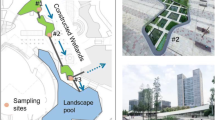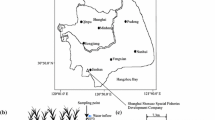Abstract
A new constructed wetland was built to purify one polluted river in Taiwan, and this study was conducted to evaluate the treatment efficiency of the wetland. Due to the very limitation of available budget, several water quality items, which were stipulated by Taiwan’s Environmental Protection Administration for rivers, in the influent and effluent of wetland were analyzed and evaluated. These items included water temperature, pH, DO, BOD5, TSS, and NH4 +-N. The results showed that the average removal rates of total (unfiltered) BOD5, TSS and NH4 +-N were 36.9 %, 71.8 % and 47.1%, respectively. With the HRT more than 3.4 days, the wetland could treat the polluted river water effectively. Longer HRT in this wetland appeared no obvious improvement on the removal rate of TSS or NH4 +-N. However, BOD removal rate increased while the HRT (Hydraulic Retention Time) increased to about 5 days. In this wetland, the calculated mean first-order reaction rate constant (kT) for BOD5 was 0.15/day with a standard deviation of 0.13/day and for NH4 +-N was 0.24/ day with a standard deviation of 0.18/day. It is also concluded that there is a linear proportional relationship between BOD concentrations in the effluent of wetland and its influent mass loading rates, with the coefficient of determination (R2) of 0.6511. Similar result was seen for NH4 +-N as well, with the coefficient of determination (R2) of 0.5965. TSS removal rate was found to be linearly proportional to its influent mass loading rate, with the coefficient of determination (R2) of 0.4875.
Similar content being viewed by others
References
Alam, Md.J.B.; Islam, M.R.; Muyen, Z.; Mamun, M.; Islam, S. (2007). Water quality parameters along rivers. Int. J. Environ. Sci. Tech., 4(1), 159–167.
Clesceri, L.S.; Greenberg, A.E.; Eaton, A.D., (2001). Standard methods for the examination of water and wastewater. American Public Health Association (APHA), American Water Works Association (AWWA) and Water Environment Federation (WEF).
Coveney, M.F.; Stites, D.L.; Lowe, E.F.; Battoe, L.E.; Conrow, R., (2002). Nutrient removal from eutrophic lake water by wetland filtration. Eco. Eng., 19(2), 141–159.
García, J.; Aguirre, P.; Mujeriego, R.; Huang, Y.; Ortiz, L.; Bayona, J.M., (2004). Initial contaminant removal performance factors in horizontal flow reed beds used for treating urban wastewater. Water Res., 38(7), 1669–1678.
Green, M.; Safray, I.; Moshe, A., (1996). Constructed wetlands for river reclamation: Experimental design, start-up and preliminary results. Bioresour. Tech., 55(2), 157–162.
Hamilton, S.K.; Sippel, S.J.; Calheiros, D.F.; Melack, J.M., (1997). An anoxic event and other biogeochemical effects of Pantanal wetland on the Paraguay river. Limnol. Oceanogr., 42(2), 257–272.
Jing, S.R.; Lin, Y.F.; Lee, D.Y.; Wang, T.W., (2001). Nutrient removal from polluted river water by using constructed wetlands. Bioresour. Tech., 76(2), 131–135.
Jing, S.R.; Lin, Y.F.; Lee, D.Y.; Wang, T.W., (2002). Performance of constructed wetlands planted with various macrophytes and using high hydraulic loading. J. Environ. Qual., 31(2), 690–696.
Kadlec, R.H.; Knight, R.L. (1996). Treatment wetlands. Florida: Lewis-CRC Press.
Kovacic, D.A.; Twait, R.M.; Wallace, M.P.; Bowling, J.M., (2006). Use of created wetlands to improve water quality in the Midwest — Lake Bloomington case study. Eco. Eng., 28(3), 258–270.
Reed, S.C. (2000). Land treatment systems for municipal and industrial wastes. McGraw-Hill, USA.
Sakadevan, K.; Bavor, H.J., (1998). Phosphate adsorption characteristics of soils, slags and zeolite to be used as substrates in constructed wetland systems. Water Res., 32(2), 393–399.
USEPA (2000a). Constructed wetlands treatment of municipal wastewaters. EPA Manual, EPA/625/R-99/010, USA.
USEPA., (2000b). Guiding principles for constructed treatment wetlands. EPA, USA.
Voeks, R.A.; Rahmatian, M., (2004). The providence of nature: Valuing ecosystem services. Int. J. Environ. Sci. Tech., 1(2), 151–163.
Wiessner, A.; Kappelmeyer, U.; Kuschk, P.; Kästner, M., (2005). Sulphate reduction and the removal of carbon and ammonia in a laboratory-scale constructed wetland. Water Res., 39, 4643–4650.
Author information
Authors and Affiliations
Corresponding author
Rights and permissions
About this article
Cite this article
Juang, D.F., Chen, P.C. Treatment of polluted river water by a new constructed wetland. Int. J. Environ. Sci. Technol. 4, 481–488 (2007). https://doi.org/10.1007/BF03325984
Received:
Revised:
Accepted:
Published:
Issue Date:
DOI: https://doi.org/10.1007/BF03325984




